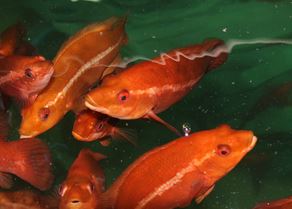Scaling up production and implementation of farmed cleaner fish
The overarching goal of the project was to scale up Ballan wrasse production by domesticating the species and optimising broodstock management, larval rearing, nutritional requirements, management of bacterial infections, and post-deployment performance and welfare.
Project Summary
Project life: 42 months
Anticipated benefits
Increased harvest volumes of salmon and reduced reliance on medicinal controls, with the knock-on benefits of job creation in rural areas and improved public understanding of the environmental sustainability of salmon farming.
£4.1m
Total Value
74%
Industry Contribution
21%
SAIC Contribution
5%
Academia Contribution
This collaboration has proven to be a landmark in the development of farmed ballan wrasse, not just in Scotland but globally. The discoveries made and new knowledge gained have significantly advanced our understanding of many of the fundamental areas of fish welfare and biological control of sea lice, and in doing so will help pave the way for successfully scaling up wrasse production. – Ralph Bickerdike, Head of Fish Health & Welfare, Scottish Sea Farms
Ralph Bickerdike, Head of Fish Health & Welfare, Scottish Sea Farms
The project provided new knowledge that has been directly applied to the development of wrasse-specific hatchery and post-deployment feeds – Patrick Campbell, MD of BioMar UK and Vice President Salmon of BioMar Group
Patrick Campbell, MD of BioMar UK and Vice President Salmon of BioMar Group
The project has brought a plethora of results that can ultimately be used within the production hatcheries to improve fish health and welfare. Techniques developed by the various researchers in association with farm staff will improve fish husbandry and allow further innovation under production conditions – Dougie Hunter, Technical Director, Mowi Scotland
Dougie Hunter, Technical Director, Mowi Scotland
Partners
-
Institute of Aquaculture, University of Stirling
-
Mowi Scotland
-
Scottish Sea Farms
-
BioMar
-
Otter Ferry Seafish
Case study
This project is now complete. You can download a PDF of the full case study by clicking the button below.
Download Full Case Study PDF
Impact
The project was very successful and fully achieved its goals. Scaling up the production of Ballan wrasse mainly focussed on developing the rearing processes for this species to increase production but also acclimatise farmed Ballan wrasse for effective delousing. Seven processes were developed or optimised:
- Sex induction to provide males
- New vaccine and efficacy confirmed
- Genetic marker panel for genotyping
- Egg management by degumming and disinfecting
- Deployment protocols for natural behaviour with diurnal rhythmicity
- Enhanced live feed enrichments
- Husbandry conditions for enhanced growth performances
Parental assignment developed as a service that will allow the genetic improvement of the species through selective breeding. Two products were improved:
- Further validation of wrasse feed blocks developed by Stirling academics
- Wrasse hides and furnishings.
During the project first generation (F1) broodstock were bred in captivity, which is a world first for the species. This opens many possibilities for the future, especially the improvement of the species traits by selection. The project was awarded the Applied Research Award at the Aquaculture Awards 2019.
Speaking on the value of the project to the academic team, Prof. Herve Migaud said: “This project helped IoA scientists involved to become and remain the leading scientists working on cleaner fish research and overall on integrated sea lice pest management strategies and work closely with the leading salmon industry partners in the UK.”
Three PhD projects and ten MSc theses were authored as part of this project by students at the Institute of Aquaculture, University of Stirling.
Reporting on the project’s legacy, Dougie Hunter, Technical Director at Mowi Scotland, said: “The project has brought a plethora of results that can ultimately be used within the production hatcheries to improve fish health and welfare. Techniques developed by the various researchers in association with farm staff will improve fish husbandry and allow further innovation under production conditions.”
Ballan wrasse is a type of ‘cleaner fish’ which eats naturally occurring marine parasites, such as sea lice, from salmon. The majority of wrasse used in this way has been sourced from the wild in accordance with the guidelines from Marine Scotland, RSPCA Assured and local fishery boards. The aim of this project was to develop an aquaculture system for Ballan Wrasse in order to provide a sustainable stock.

The natural lifecycle of wrasse is six years and over this time, the project team bred wild-caught wrasse, raising the offspring from egg to adults of reproductive age. These offspring have now produced their own eggs and successfully hatched, the first fully farmed lifecycle of wrasse in a controlled environment.
This has provided a proven, repeatable procedure for breeding, weaning and rearing wrasse and will lead to a reduced reliance on wild stock.